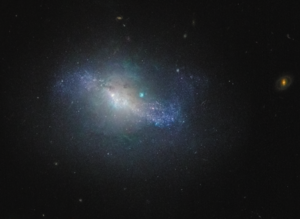NGC 4670
| Galaxy NGC 4670 |
|
|---|---|

|
|
| Image of NGC 4670 using data from the Hubble Space Telescope | |
| AladinLite | |
| Constellation | Berenike's hair |
|
Position equinox : J2000.0 , epoch : J2000.0 |
|
| Right ascension | 12 h 45 m 17.1 s |
| declination | + 27 ° 07 ′ 31 ″ |
| Appearance | |
| Morphological type | SB (s) 0 / a / pec: / BCDG |
| Brightness (visual) | 12.2 mag |
| Brightness (B-band) | 13.1 mag |
| Angular expansion | 1.4 x 1.2 |
| Position angle | 90 ° |
| Surface brightness | 12.6 mag / arcmin² |
| Physical data | |
| Redshift | 0.003566 ± 0.000013 |
| Radial velocity | (1069 ± 4) km / s |
|
Stroke distance v rad / H 0 |
(48 ± 3) x 10 6 ly (14.7 ± 1.0) Mpc |
| history | |
| discovery | Wilhelm Herschel |
| Discovery date | April 6, 1785 |
| Catalog names | |
| NGC 4670 • UGC 7930 • PGC 42987 • CGCG 159-069 • MCG + 05-30-072 • IRAS 12428 + 2724 • 2MASX J12451714 + 2707317 • Arp 163 • GC 3201 • H III 328 • h 1422 • LDCE 867 NED126 | |
NGC 4670 = Arp 163 is a 12.2 mag bright lenticular dwarf galaxy of the Hubble type SB0 / a in the constellation Haar der Berenike in the northern sky . It is estimated to be 48 million light years from the Milky Way and about 20,000 light years in diameter.
Halton Arp organized his catalog of unusual galaxies into groups according to purely morphological criteria. This galaxy belongs to the class of diffuse filament galaxies .
In the same area of the sky are u. a. the galaxies NGC 4673 and NGC 4692 .
The object was discovered on April 6, 1785 by Wilhelm Herschel with an 18.7-inch reflector telescope, who described it as "F, S".
literature
- Jeff Kanipe and Dennis Webb: The Arp Atlas of Peculiar Galaxies - A Chronicle and Observer's Guide , Richmond 2006, ISBN 978-0-943396-76-7
Web links
Commons : NGC 4670 - collection of images, videos, and audio files
- NGC 4670. SIMBAD , accessed February 1, 2015 .
- NGC 4670. DSO Browser, accessed February 1, 2015 .
- ARP ATLAS OF PECULIAR GALAXIES
- Seligman Arp
